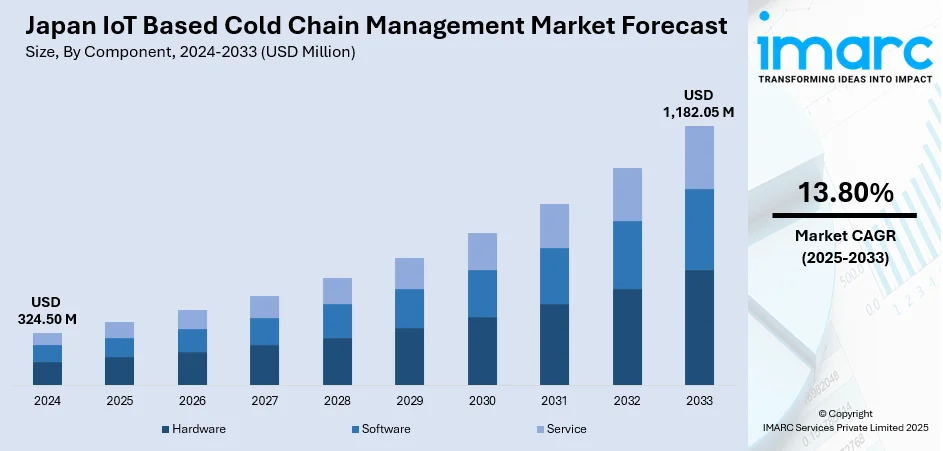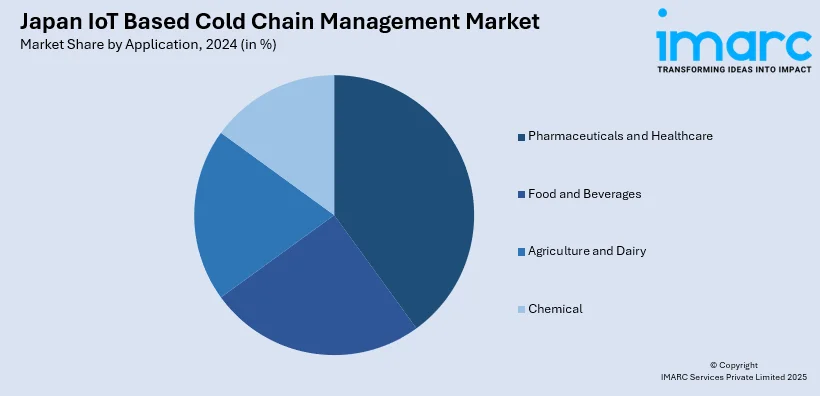
Japan IoT Based Cold Chain Management Market Size, Share, Trends and Forecast by Component, Application, Technology, and Region, 2025-2033
Japan IoT Based Cold Chain Management Market Overview:
The Japan IoT based cold chain management market size reached USD 324.50 Million in 2024. Looking forward, IMARC Group expects the market to reach USD 1,182.05 Million by 2033, exhibiting a growth rate (CAGR) of 13.80% during 2025-2033. The growth of e-commerce, particularly in online grocery shopping, is driving the demand for Internet of Things (IoT)-based cold chain solutions in Japan to ensure the quality and safety of perishable goods. Additionally, the expanding pharmaceutical and biotech sectors, which require secure, temperature-controlled logistics, are contributing to the expansion of the Japan IoT based cold chain management share.
|
Report Attribute
|
Key Statistics
|
|---|---|
|
Base Year
|
2024
|
|
Forecast Years
|
2025-2033
|
|
Historical Years
|
2019-2024
|
| Market Size in 2024 | USD 324.50 Million |
| Market Forecast in 2033 | USD 1,182.05 Million |
| Market Growth Rate 2025-2033 | 13.80% |
Japan IoT Based Cold Chain Management Market Trends:
Growth of Pharmaceutical and Biotech Sectors
The swift expansion of Japan's pharmaceutical and biotech industries is driving the need for safe, temperature-regulated logistics. Numerous pharmaceutical products, such as vaccines, insulin, and biologics, require precise temperature control to maintain their effectiveness during transport and storage. To fulfill these requirements, the cold chain management market based on IoT is becoming essential. IoT-enabled systems offer continuous monitoring, immediate alerts, and data recording, ensuring that products remain within the necessary temperature ranges throughout every stage of the supply chain. This is especially crucial as Japan's drug industry becomes more prominent through government initiatives and private fundings. For instance, in 2025, Japan launched a decade-long government initiative to support innovative drug development, with the goal of decreasing the nation's dependence on imported medications. Such initiatives are catalyzing the demand for sophisticated cold chain solutions to manage newly developed drugs and biologics, which often have specific and stringent temperature requirements. IoT technologies play a crucial role in adhering to these regulations, ensuring alignment with health authorities' standards and avoiding spoilage or decreased product effectiveness. As the governing body seeks to enhance its pharmaceutical ecosystem, the demand for reliable IoT-based cold chain management solutions is rising, thereby strengthening the Japan IoT based cold chain management market growth. With Japan's ongoing investment in healthcare innovation, firms in the pharmaceutical and biotech industries are increasingly utilizing IoT technology to monitor the temperature of their temperature-sensitive products, ensuring that quality and safety are maintained throughout the supply chain.

To get more information on this market, Request Sample
Rising E-commerce and Online Grocery Shopping Trends
The rapid growth of e-commerce, particularly in online grocery shopping, is significantly influencing Japan's cold chain management market utilizing IoT technology. With more people opting for digital platforms to buy perishable items, such as fresh produce, dairy products, and meat, the need for effective, temperature-regulated logistics is rising. The Japanese e-commerce sector is anticipated to attain USD 692.8 billion by 2033, demonstrating a strong growth rate of 11.02% between 2025 and 2033, making the assurance of quality and safety of these products during last-mile delivery essential. To fulfill these requirements, IoT technology is crucial for tracking temperature, humidity, and storage conditions across the supply chain. Real-time monitoring and predictive analysis ensure that products remain within the necessary temperature ranges during transportation, maintaining their freshness and preventing spoilage. For instance, major grocery delivery companies in Japan utilize IoT-driven cold chain solutions to monitor and maintain optimal conditions in refrigerated trucks and storage spaces, ensuring that items like dairy, meat, and vegetables arrive to consumers in their highest quality. With an increase in direct deliveries to buyers, businesses are turning to IoT systems to guarantee smooth, secure, and dependable last-mile logistics. The shift in individual habits and the growing demand for fresh, premium products are driving the adoption of cold chain management systems.
Japan IoT Based Cold Chain Management Market Segmentation:
IMARC Group provides an analysis of the key trends in each segment of the market, along with forecasts at the country and regional levels for 2025-2033. Our report has categorized the market based on component, application, and technology.
Component Insights:
- Hardware
- Sensors
- RFID Tags
- GPS Devices
- Software
- Cloud Platforms
- Analytics Tools
- Service
- Consulting
- Maintenance
- Integration
A detailed breakup and analysis of the market based on the component have also been provided in the report. This includes hardware (sensors, RFID tags, and GPS devices), software (cloud platforms and analytics tools), and service (consulting, maintenance, and integration).
Application Insights:

- Pharmaceuticals and Healthcare
- Food and Beverages
- Agriculture and Dairy
- Chemical
The report has provided a detailed breakup and analysis of the market based on the application. This includes pharmaceuticals and healthcare, food and beverages, agriculture and dairy, and chemical.
Technology Insights:
- Bluetooth
- Cellular Network
- Satellite Network
A detailed breakup and analysis of the market based on the technology have also been provided in the report. This includes Bluetooth, cellular network, and satellite network.
Regional Insights:
- Kanto Region
- Kansai/Kinki Region
- Central/ Chubu Region
- Kyushu-Okinawa Region
- Tohoku Region
- Chugoku Region
- Hokkaido Region
- Shikoku Region
The report has also provided a comprehensive analysis of all the major regional markets, which include Kanto Region, Kansai/Kinki Region, Central/ Chubu Region, Kyushu-Okinawa Region, Tohoku Region, Chugoku Region, Hokkaido Region, and Shikoku Region.
Competitive Landscape:
The market research report has also provided a comprehensive analysis of the competitive landscape. Competitive analysis such as market structure, key player positioning, top winning strategies, competitive dashboard, and company evaluation quadrant has been covered in the report. Also, detailed profiles of all major companies have been provided.
Japan IoT Based Cold Chain Management Market News:
- In May 2024, ITE Corporation unveiled its IceBattery® system and real-time IoT monitoring solutions, revolutionizing cold chain logistics for life sciences in Japan. These systems offered precise temperature control from -50°C to +25°C and nationwide last-mile delivery for sensitive items like vaccines and regenerative medicines. The solution improved safety, reduced reliance on dry ice, and ensured reliable transport even in extreme conditions.
Japan IoT Based Cold Chain Management Market Report Coverage:
| Report Features | Details |
|---|---|
| Base Year of the Analysis | 2024 |
| Historical Period | 2019-2024 |
| Forecast Period | 2025-2033 |
| Units | Million USD |
| Scope of the Report |
Exploration of Historical Trends and Market Outlook, Industry Catalysts and Challenges, Segment-Wise Historical and Future Market Assessment:
|
| Components Covered |
|
| Applications Covered | Pharmaceuticals and Healthcare, Food and Beverages, Agriculture and Dairy, Chemical |
| Technologies Covered | Bluetooth, Cellular Network, Satellite Network |
| Regions Covered | Kanto Region, Kansai/Kinki Region, Central/ Chubu Region, Kyushu-Okinawa Region, Tohoku Region, Chugoku Region, Hokkaido Region, Shikoku Region. |
| Customization Scope | 10% Free Customization |
| Post-Sale Analyst Support | 10-12 Weeks |
| Delivery Format | PDF and Excel through Email (We can also provide the editable version of the report in PPT/Word format on special request) |
Key Questions Answered in This Report:
- How has the Japan IoT based cold chain management market performed so far and how will it perform in the coming years?
- What is the breakup of the Japan IoT based cold chain management market on the basis of component?
- What is the breakup of the Japan IoT based cold chain management market on the basis of application?
- What is the breakup of the Japan IoT based cold chain management market on the basis of technology?
- What is the breakup of the Japan IoT based cold chain management market on the basis of region?
- What are the various stages in the value chain of the Japan IoT based cold chain management market?
- What are the key driving factors and challenges in the Japan IoT based cold chain management market?
- What is the structure of the Japan IoT based cold chain management market and who are the key players?
- What is the degree of competition in the Japan IoT based cold chain management market?
Key Benefits for Stakeholders:
- IMARC’s industry report offers a comprehensive quantitative analysis of various market segments, historical and current market trends, market forecasts, and dynamics of the Japan IoT based cold chain management market from 2019-2033.
- The research report provides the latest information on the market drivers, challenges, and opportunities in the Japan IoT based cold chain management market.
- Porter's five forces analysis assist stakeholders in assessing the impact of new entrants, competitive rivalry, supplier power, buyer power, and the threat of substitution. It helps stakeholders to analyze the level of competition within the Japan IoT based cold chain management industry and its attractiveness.
- Competitive landscape allows stakeholders to understand their competitive environment and provides an insight into the current positions of key players in the market.
Need more help?
- Speak to our experienced analysts for insights on the current market scenarios.
- Include additional segments and countries to customize the report as per your requirement.
- Gain an unparalleled competitive advantage in your domain by understanding how to utilize the report and positively impacting your operations and revenue.
- For further assistance, please connect with our analysts.
 Request Customization
Request Customization
 Speak to an Analyst
Speak to an Analyst
 Request Brochure
Request Brochure
 Inquire Before Buying
Inquire Before Buying




.webp)




.webp)












